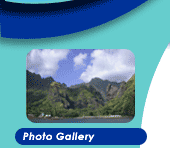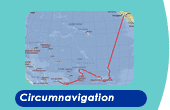March
21, 2001
Quepos,
Costa Rica
Rainmaker
By Lois Joy  
We awoke with anticipation. Today, the tour van would meet us
at the gates of the Quepos fishing dock, and we would travel about 14
km inland to visit the Rainmaker, a 2000-hectare preserve. An
ecotourism project that opened in 1997, Rainmaker mimics aerial
walkways in the Peruvian Amazon and in Asia. It is the first such
project in Central America. Visitors walk through the rainforest
canopy on a series of suspension bridges attached to the largest trees
in the forest.
As the van took us inland, we bypassed bridges under construction by
going around and through dry creek beds, a sometimes-bumpy ride. We
went over one bridge I’d rather have gone around—it was a
pile of rust. Gunter asked to stop and take a photo of the sign. It’s
message was: “Danger. Crocodiles. Do not swim here.”
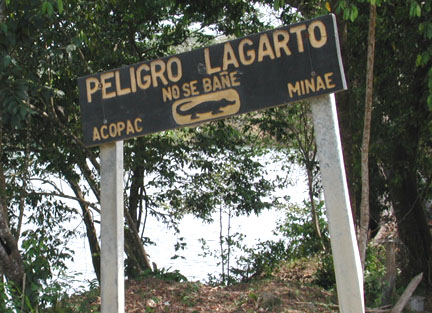
Danger of Crocodiles. Do not swim.
After arriving at the preserve, we had a fruit and juice snack with
three others who would be on our tour, a new grandmother and her two
daughters, 17 and 25, who came from the United States to visit their
28-year-old son whose wife had just delivered a baby the day before. Our
guide was a Costa Rican naturalist who had completed his graduate degree
in Ames, Iowa.
We walked past a man-made “Walden’s Pond” area and then
through a magical rainforest canyon. A series of wooden walkways and
bridges have been built all along the canyon floor to avoid damaging
the bottom. A pristine stream tumbled down the rocks from a divided
waterfall.
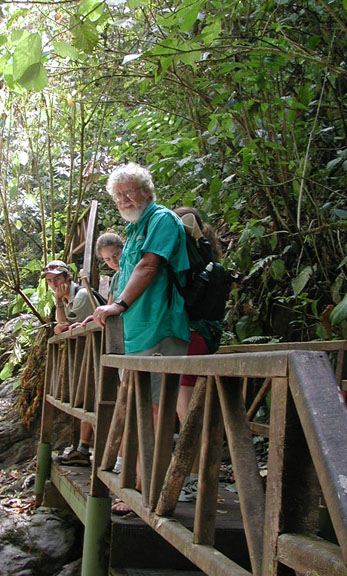
Tour group views the waterfalls and
pool below.
After a mile or so, just when we were beginning to sweat, our guide
pointed out waterfalls with a shallow pool with a rope swing.
We were invited to swim in the refreshingly cold water. What a
treat!
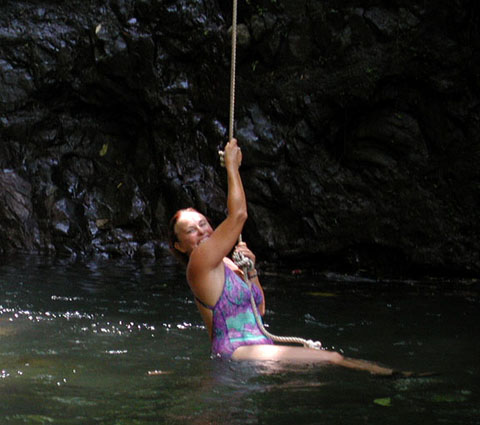
Lois swings on the rope.
It was good that we had the opportunity to cool off, because from there
we climbed up several hundred steps to a tree platform. On the way,
we noticed a suspension bridge high, high up there, spanning the entire
canyon. The grandmother looked at the bridge and burst out, “Oh,
my God.”
“That what we named it,” our guide said smugly. “It
is called the Oh My God bridge. And you understand why. Everyone says
this. It hasn’t opened yet, but we’re going up there. You’ll
get to see it.”
“We can’t go on it?” I asked, disappointed.
“Well, the inspector is due today. It’s ready. It is scheduled
to open in four days. Perhaps we’ll be lucky.”
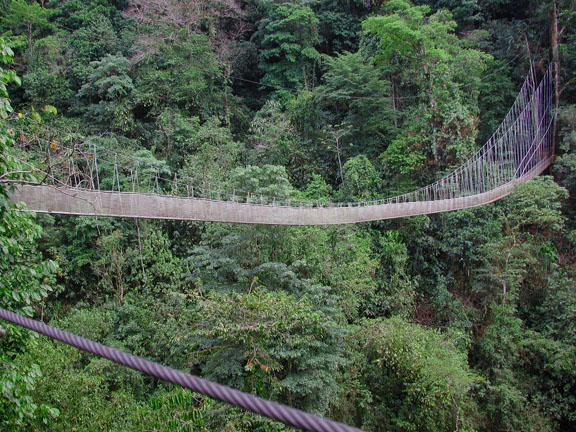
View of Oh My God bridge from the
trail.
We stowed our backpacks on the first platform, and walked through a
maze of footbridges and platforms. A sign before each platform
and bridge posted the maximum number of people allowed. For some
transits, our group was divided to four or less at a time. We strained
our eyes, looking for animal life in the dense canopy. We saw
bright blue and blue-and-yellow butterflies, and a blue hummingbird. Finally,
through binoculars, we saw a toucan with its oversized yellow bill,
flying to the top of a tree high over the canyon. I would think
it would get too top heavy to fly with such a bill! Although these toucans
are featured on every promotional brochure, and replicas are in every
souvenir shop in Costa Rica, actually spotting one is rare, according
to our guide. We saw no mammals. They are best seen in the
early morning hours or at dusk, and by the time we reached the forest
canopy, it was 11:00 AM.
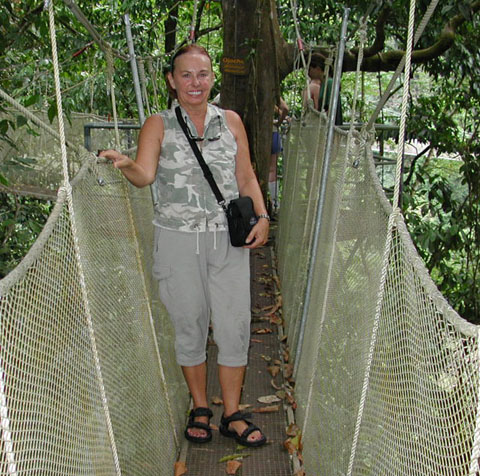
Lois on one of the footbridges.
As we traveled higher and higher, we again saw a glimpse of the new
suspension bridge through the forest. It was beautiful, grand and tantalizing.
I could not stand coming this far on this tour, only to have this bridge
open—for a different tour, in only four days. But I didn’t
say anything…yet.
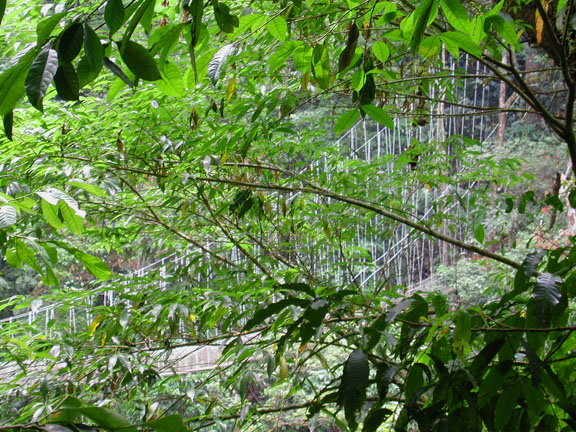
We gain a glimpse of the suspension
bridge through the dense forest.
Finally, we arrived at the platform preceding the bridge. We looked
over into the deep canyon. We were now 25 stories above the canyon floor!
“How long is it? I asked.
“This bridge is 310 feet long. It is the longest and highest suspension
bridge of its type in the world,” our guide answered proudly. “You
would have to go to the Amazon or to the Orient to walk on a bridge
like this.”
That did it. I must walk on the bridge.
“Could we just go on it for a little ways? I asked.
“I’m thinking of allowing each party to go halfway.”
“Why halfway, that is strange,” I thought to myself. Later,
I found that the pathway on the other side has yet to be completed.
So Gunter and I were allowed to go first. I went to the middle, stood
there for a minute, in awe of the waterfalls and canyon floor, so small
below. Gunter took my photo. I came back and then took Gunter’s
photo as he went to the middle. (See those photos in Photo Gallery.)
Then our guide took a closer photo of the two of us.
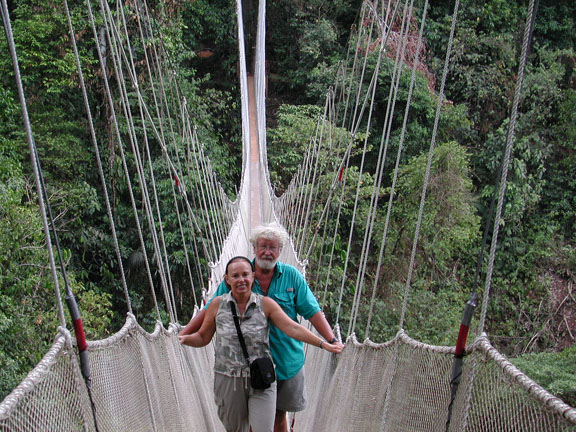
Lois and Gunter on suspension bridge.
Since the round trip trail has yet to be developed, we took the same
way back. Our guide pointed out various plants along the way.
I was thrilled to see the delicate white blooms of a begonia growing
in the wild. We returned to a thatched roof Great House, where
we enjoyed a wonderful buffet lunch of native Costa Rican dishes.
<Page 2>
*Researching this later, I found
out that the bills of toucans are actually very light because they are
almost hollow, supported internally by thin cross struts. The
purpose of these greatly oversized beaks is unknown. They prefer
to stay in the treetops and nest there in holes in the trees.
journal36.html |





